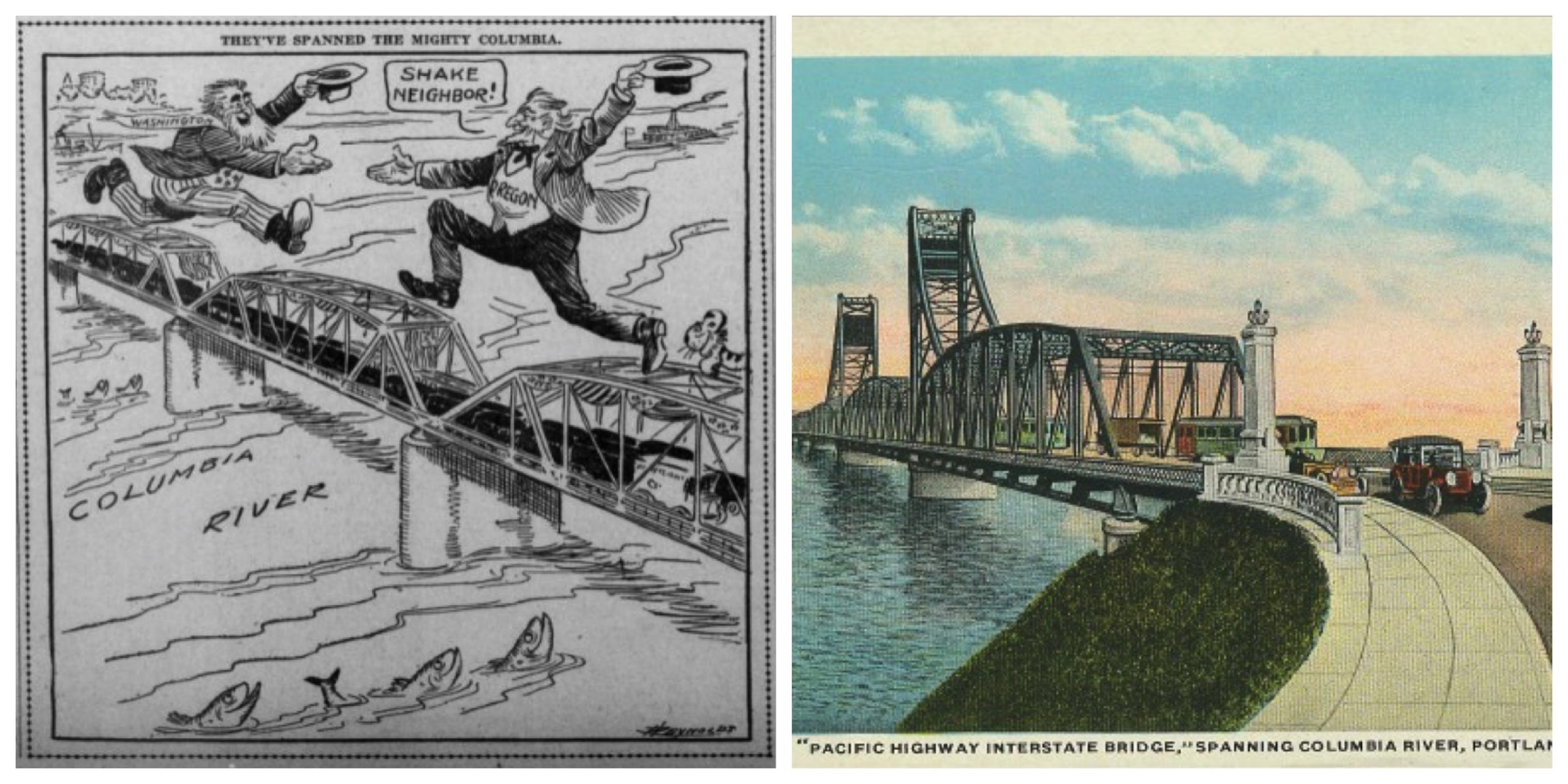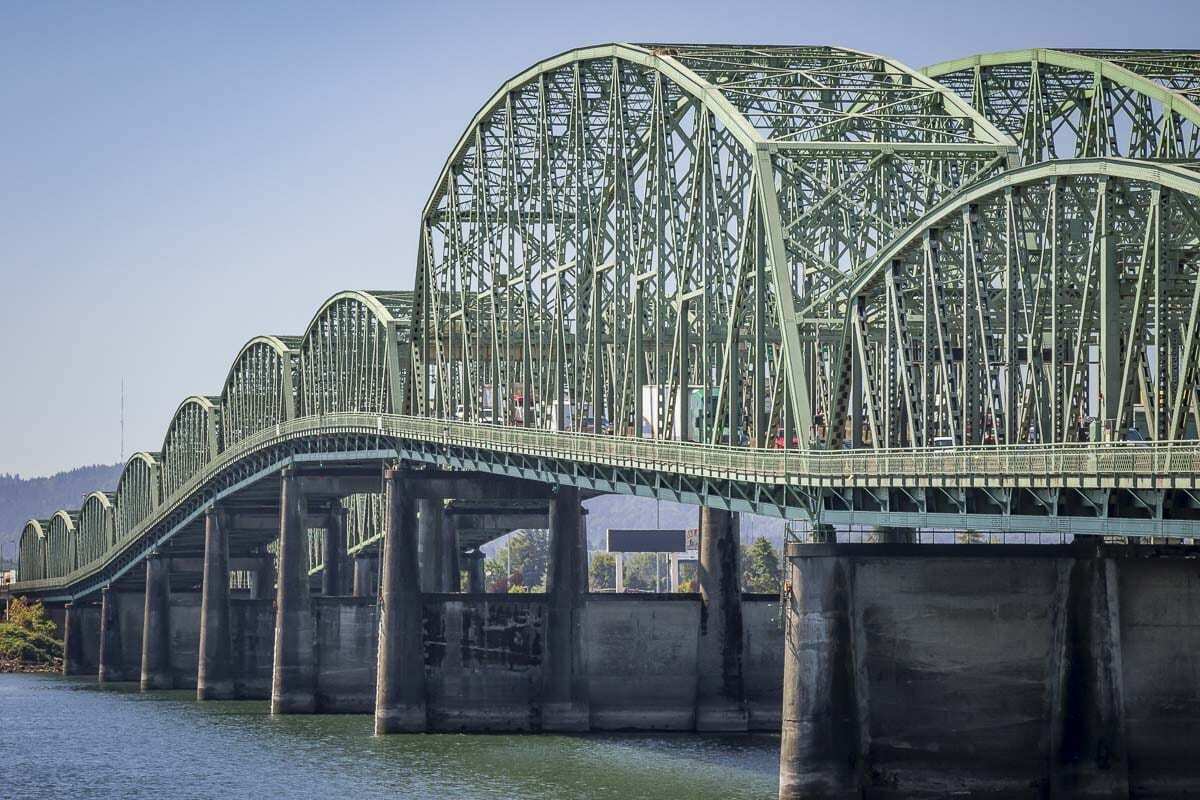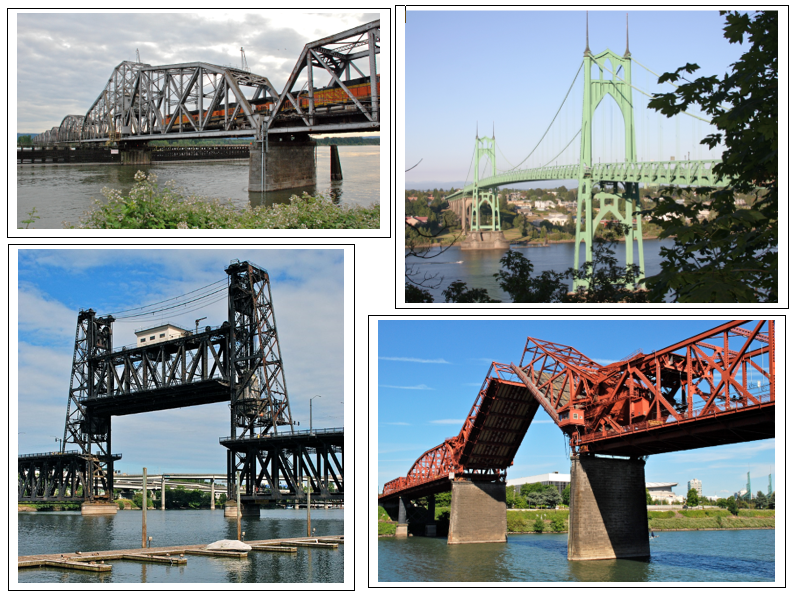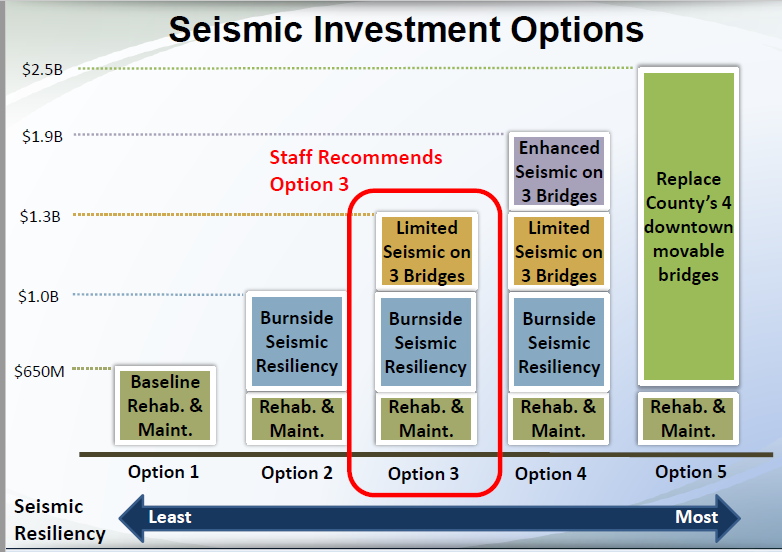How many bridges are 100 years old?
The Interstate Bridge first opened Feb. 15, 1917 as a single structure — today’s northbound lane of Interstate 5. It served traffic in both directions and also had a trolley lane. The bridge cost $1.7 million and had a nickle toll. The tolls ended in 1929 after the two states purchased the bridge from Multnomah and Clark counties.
The Morning Oregonian reported: “Oregon extended a big, brotherly hand to Washington, and Portland welcomed with open arms her old neighbor, Vancouver. They all fell into each other’s ardent embrace, happy over the final realization of an improvement that had been a dream for a half century or more.”
Forty years later, a second bridge was built adding an additional three lanes to what would become Interstate 5. The northbound bridge was then closed and received an upgrade. It opened to traffic in 1960. Tolls of 20 cents were collected until 1966 to help pay for the second bridge and the upgrade to the original structure.
In 1957, the Interstate Bridge became part of the newly created Interstate 5. It was added to the National Register of Historic Places in 1982.

Today, citizens often hear from elected leaders and transportation officials that “the bridge is over 100 years old and needs to be replaced.” In reality, half the bridge is over 100 years old, and it received an upgrade from 1958-1960. The southbound structure is 60 years old. Neither ODOT nor WSDOT declare either bridge structure “unsafe.”
Both spans were labeled “functionally obsolete,” but that simply means they don’t meet current freeway standards. Today, that description has been replaced by the Federal Highway Administration (FHA) numbering system of 9-0, where 9 is the highest showing “excellent condition” and 0 or zero is “failed condition.” The functionally obsolete label became a “3” or “serious condition,” but not “critical” (2) or “imminent failure (1) or a zero.
In January, Tom Gentry – community member of the Interstate Bridge Replacement Project (IBRP) Community Advisory Group (CAG) – asked: “Is the current bridge being removed, repurposed or replaced?”
IBRP administrator Greg Johnson answered Gentry with the following. “We’ve looked at it and the operational cost and the maintenance costs of keeping the existing bridge and making a different connection would be overwhelming. So right now, the plans would be to remove the existing bridge.”
The IBRP website states “Operating and maintaining these aging structures costs around $1.2 million each year, split evenly between ODOT and WSDOT. Larger maintenance projects to keep the Interstate Bridge in service are expected to cost over $280 million through the year 2040, not including seismic retrofit.” That equates to about $14 million per year in “larger maintenance” costs.
Specific details of those operational and maintenance costs and “making a different connection” cost, have not been fully shared with taxpayers.
Clark County Today reached out to the IBRP team and asked the following:
“Can you get for us better, more detailed information on what the IBRP team believes the “operational cost and the maintenance costs” of keeping the existing bridge would be? After all, we’re talking about possibly spending $4 billion to $5 billion dollars, so taxpayers would like more than a generalization to use in evaluating the choices.
Does the team have any idea (extremely rough ballpark), on what the cost of a “different connection” would be? Obviously that would depend on where the connection was built, how many intersections needed to be added, is that different connection interstate or simply a bi-state highway, etc.“

Ray Mabey, IBR Assistant Program Administrator/ODOT State Bridge Engineer responded to our questions with the following statement.
Both spans of the Interstate Bridge are currently rated as “Fair” on the Federal Highway Administration National Bridge Inventory. The longer they go without replacement, the more their condition rating will deteriorate. Significant ongoing investment is needed to operate and maintain the existing structures and those costs will continue to increase as the bridge continues to age. Annual operations and maintenance costs are currently around $1.2 million each year and are split evenly between ODOT and WSDOT. Larger maintenance projects to keep both spans of the bridge in service are estimated to cost over $270 million between now and 2040 (including southbound bridge painting, southbound & northbound bridge deck replacement, and electrical systems). This estimate does not include costs associated with established seismic vulnerabilities, so these repairs would be necessary just to keep the bridges operating but would not improve current conditions.
In addition to the ongoing maintenance and operations costs, there were a number of other challenges previously identified that led to the decision not to reuse the existing bridge. Even if the existing bridge were to be retrofitted, it is not practically feasible to bring it up to modern seismic standards or fully address the safety issues associated with the existing roadway design. Any supplemental or arterial bridge options were also found to have greater impacts associated with the environment, Hayden Island, the Fort Vancouver National Historic Reserve, river navigation, and local streets.
Given the number of variables that would need to be considered, it is not possible to provide an accurate estimated cost for a new crossing across the Columbia River without additional detail and data. Factors such as the river and soil conditions at the location of the crossing, potential property and land use impacts, environmental mitigation, the extent of new infrastructure needed to connect into the existing transportation networks, and a number of other details would all impact the potential scope and scale of costs to construct a new crossing.
The region’s long-term transportation plans do not currently include the creation of a new corridor across the Columbia River. While a discussion about a potential new crossing is certainly an important conversation that should be had, the current priority is addressing the existing need for improvements on the I-5 corridor to ensure that it keeps travelers and freight moving throughout the region safely for many years to come.
Citizens know that $13 million was just spent replacing a 100-year-old trunnion on the Interstate Bridge last fall. The new trunnion could last for the next century if the bridge isn’t destroyed in a replacement project.
Century old bridges
Some citizens might ask if we really have to destroy our historic bridge? Others might wonder, how many 100-year-old bridges are there?
The FHA tracks this data. As of Dec. 2019, it reports the USA has 12,990 bridges that are 100 years of age or older. There are 1,736 that are 120 years or older.
Washington has 177 bridges over the age of 100. Oregon has 83 bridges 100 or older.
In addition, there are 17,207 bridges that are 90-99 years old. Washington has 218 and Oregon 208. That brings the total number of bridges 90 years and older to 30,197, with Washington having 395 and Oregon having 291.
The FHA also lists bridges by “good,” “fair” and “poor” categories. Of the 100 years and older bridges, Washington has 29 labed “good,” 133 “fair,” and 15 are “poor.” Oregon has five that are “good,” 61 “fair,’’ and 19 that are “poor.”
Old bridges in the Portland area
The BNSF rail bridge was completed in 1908, it was the first bridge of any kind to be built across the lower Columbia River, preceding the first road bridge, the nearby Interstate Bridge, by a little more than eight years.
The Hawthorne Bridge is a truss bridge with a vertical lift that spans the Willamette River in Portland, It is the oldest vertical-lift bridge in operation in the United States and the oldest highway bridge in Portland. It opened for traffic in 1910.
The Steel Bridge is a through-truss, double-deck vertical-lift bridge across the Willamette River in Portland, which opened in 1912. The lower deck carries railroad and bicycle/pedestrian traffic. The upper deck carries vehicle traffic and light rail (MAX). It is the only double-deck bridge with independent lifts in the world and the second oldest vertical-lift bridge in North America, after the nearby Hawthorne Bridge.
The Broadway Bridge is a bascule bridge built in 1913. It was Portland’s first bascule bridge, and it continues to hold the distinction of being the longest span of its bascule design type in the world.
The Burnside Bridge was built in 1926.

Old bridges around the USA
The Eads Bridge is a combined road and railway bridge over the Mississippi River connecting the cities of St. Louis, Missouri and East St. Louis, Illinois. It is the oldest steel bridge in the nation; 43 years older than the Interstate 5 Bridge. Work on the bridge began in 1867, (two years after the Civil War ended) and was completed in 1874.
Engineering and construction principles first used on the Eads Bridge, were later used to build the famous Brooklyn Bridge. The bridge spans the East River between Manhattan and Brooklyn and opened in 1883, 34 years prior to our Interstate Bridge. It was the world’s longest suspension bridge at the time of its opening. The Brooklyn Bridge has been renovated several times, including in the 1950s, 1980s, and 2010s.
Nearby, the Williamsburg Bridge is a suspension bridge in New York City across the East River opened in 1903. It has eight lanes of roadway. The Queensboro Bridge is a cantilever bridge over the East River, completed in 1909. It has nine lanes, four upper and five lower for traffic and one lane for pedestrians and bicycles. The Manhattan Bridge is a suspension bridge that crosses the East River which also opened in 1909. It carries seven lanes of traffic, plus the lower deck handles four tracks of trains from the NYC subway, and bicycles.
In the Boston area, there are dozens of bridges older than our Interstate Bridge. Many were built in the 1800’s and still carry people and vehicles.
The Echo Bridge opened in 1877 and supports an aqueduct and pedestrians.The Harvard Bridge is the longest to span the Charles River, and opened in 1891.The Charles River Dam Bridge opened in 1910 and is a six-lane bascule bridge.
Crossing the Mississippi River are many, many old bridges. The Keokuk Bridge is a double-deck, single-track railway and highway bridge connecting Iowa and Illinois. It was constructed 1915–1916 on the piers of its predecessor that was constructed in 1869–1871.
The Government Bridge or Arsenal Bridge spans the Mississippi River, connecting Rock Island, Illinois and Davenport, Iowa. It was opened in 1896, but was built at the location of a bridge first built in 1855.
Out west, the most famous bridges are the Golden Gate Bridge which opened in 1937 and the Oakland Bay Bridge which opened six months earlier. Both began construction in 1933. Even after the 1989 Loma Prieta earthquake, which caused a portion of the upper deck to collapse onto the lower deck, the Bay Bridge was only closed to traffic for one month.
In Seattle, the Ballard Bridge and the Fremont Bridge both opened in 1917 and are still in use today. The University Bridge and the 12th Avenue South Bridge are two more of seven, that are 100 years of age or older. The region has roughly another dozen in the 90 and older category.
The Lewis and Clark Bridge opened in 1930, connecting Longview and Rainier.
Seismic upgrades
The cost effectiveness of repairing the Interstate bridge versus a replacement is a discussion many citizens inquire about. Why not do a seismic upgrade to preserve our historic bridge?
In Portland, Multnomah County is presently debating a replacement versus retrofit of the Burnside Bridge. The recommendation is for a long span replacement option. It has the lowest construction cost compared to other options — an estimated $825 million, That’s a 50 percent increase over the counties 2015 plan.

That 2015 Multnomah County Willamette River Bridges Capital Improvement Plan (CIP) focused on six bridges to be repaired or replaced at a total cost of $1.3 billion.
“The centerpiece of the CIP is the collection of four downtown Portland bridges: Hawthorne, Broadway, Burnside and Morrison. All four are listed on the National Historic Registry, and the first two are more than a century old. Additionally, they are all mechanically-complex bridges that open for river traffic. These iconic engineering marvels proudly grace Portland’s skyline, but they are also costly to maintain and repair by current standards.”
A 2014 Oregon Department of Transportation (ODOT) report evaluated seismic risks and costs to the state’s highway system. They recommended 138 bridges be replaced; 390 bridges be retrofitted, 190 bridges be retrofitted and rehabilitated, and 1,185 landslides and rockfalls be mitigated. The total cost of the program was estimated to be $5.1 billion in 2014. That would repair 718 bridges.
Of note in the ODOT report is the recommendation to upgrade I-205 and I-84 in their first phase. They did not recommend upgrading the Interstate Bridge. Even though the Columbia River Crossing effort had failed, they assumed a follow on project would replace it.
With $5.1 billion for ODOT bridge upgrades and another $1 billion plus in Multnomah County’s CIP bridge plan, taxpayers face over $6 billion for these repairs. Add to that the $4 billion to $5 billion now being discussed for the IBRP and the cost balloons to the $10 billion to $11 billion range.
The ODOT seismic evaluation assumed there is a 37 percent chance of an 8.0 or greater Cascadia Zone (CZ) earthquake in the next 50 years. Furthermore, they estimated that magnitude of an earthquake occurs every 350 to 500 years. Since the last one happened in 1700, the next one could happen from 2050 to 2200 or up to 180 years from now according to geologist’s estimates.
Given these realities, would it make more financial sense to do a seismic upgrade to both the Interstate Bridge and the I-205 Glenn Jackson Bridge? That would solve the immediate seismic concerns on two vital north-south transportation corridors, and it would preserve the historic Interstate Bridge.
The Interstate Bridge is also an “iconic engineering marvel” that “proudly graces Vancouver’s skyline.” If New Yorkers can cherish the Brooklyn Bridge and Californians can preserve and cherish the Golden Gate Bridge, is there anything wrong with Clark County and Portland area residents wanting to preserve and cherish the 100-year-old Interstate Bridge?
Can Oregon, once again, extend a “big brotherly hand” to Washington, and consider the transportation needs and desires of their neighbors? Is it time for a discussion about saving the bridge? The Interstate Bridge proudly stands with 12,990 other centenarians still serving their communities.




